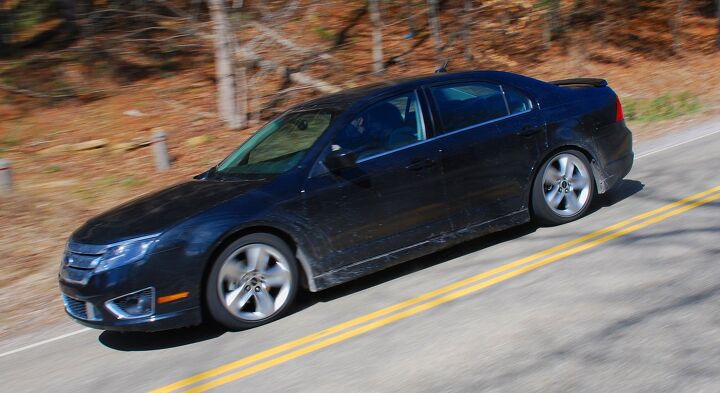As If 200,000 Fusions Cried Out In Triumph…

According to Wards Auto, the Ford Fusion is sitting at over 196,000 sales as November 30. A 200,000-unit year seems imminent. Why is this a big deal, and what does it say about Ford’s position in the marketplace when a facelift car has its best-ever year in a collapsing economy?
This is a tough time to be a Ford detractor. Like them or loathe them, the Dearborn boys have come out from the domestic collapse as the clear winners. The Focus was roundly panned by the spec-sheet-readers among the media and then went on to light up the sales charts, something I lampooned here two and a half years ago. Now we hear that the facelifted Fusion is set to have its best-ever year half a decade after its introduction.
The move from trucks to cars hasn’t hurt: Ward’s notes that
Cars have accounted for 36.8% of Ford’s deliveries through November, according to Ward’s data. In 2004, the year before the Fusion made its debut, Ford’s sales ratio was 29:71 in favor of light trucks.
Still, it has to be said that the conventional wisdom predicted that customers would flee the F-150 for the Accord and Sonata, when in fact they simply appear to have chosen a Fusion instead. A series of glowing predictions in Consumer Reports doesn’t appear to have hurt the Fusion nameplate, either. Last but certainly not least, Ford made the choice to develop and promote a very well-thought-out Fusion full hybrid while General Motors tried to bamboozle the eco-customer with a very, very mild hybrid Malibu. That “bold move” paid off in spades. Ford dealers tell me that the Fusion Hybrid is, literally, a “halo car”; buyers come in to see the battery bucket but end up taking a plain SE home.
In the “bad news” column, the Fiesta isn’t doing the numbers Ford had hoped for, selling at a rate that is approximately half that of the Yaris and one-third that of the Honda Fit. The PR spin is that the car is “popular in California”. That could be just hype, or it could be meaningful. Once upon a time, the Honda Accord was “big in California”, you know…

More by Jack Baruth
Latest Car Reviews
Read moreLatest Product Reviews
Read moreRecent Comments
- Analoggrotto I don't see a red car here, how blazing stupid are you people?
- Redapple2 Love the wheels
- Redapple2 Good luck to them. They used to make great cars. 510. 240Z, Sentra SE-R. Maxima. Frontier.
- Joe65688619 Under Ghosn they went through the same short-term bottom-line thinking that GM did in the 80s/90s, and they have not recovered say, to their heyday in the 50s and 60s in terms of market share and innovation. Poor design decisions (a CVT in their front-wheel drive "4-Door Sports Car", model overlap in a poorly performing segment (they never needed the Altima AND the Maxima...what they needed was one vehicle with different drivetrain, including hybrid, to compete with the Accord/Camry, and decontenting their vehicles: My 2012 QX56 (I know, not a Nissan, but the same holds for the Armada) had power rear windows in the cargo area that could vent, a glass hatch on the back door that could be opened separate from the whole liftgate (in such a tall vehicle, kinda essential if you have it in a garage and want to load the trunk without having to open the garage door to make room for the lift gate), a nice driver's side folding armrest, and a few other quality-of-life details absent from my 2018 QX80. In a competitive market this attention to detai is can be the differentiator that sell cars. Now they are caught in the middle of the market, competing more with Hyundai and Kia and selling discounted vehicles near the same price points, but losing money on them. They invested also invested a lot in niche platforms. The Leaf was one of the first full EVs, but never really evolved. They misjudged the market - luxury EVs are selling, small budget models not so much. Variable compression engines offering little in terms of real-world power or tech, let a lot of complexity that is leading to higher failure rates. Aside from the Z and GT-R (low volume models), not much forced induction (whether your a fan or not, look at what Honda did with the CR-V and Acura RDX - same chassis, slap a turbo on it, make it nicer inside, and now you can sell it as a semi-premium brand with higher markup). That said, I do believe they retain the technical and engineering capability to do far better. About time management realized they need to make smarter investments and understand their markets better.
- Kwik_Shift_Pro4X Off-road fluff on vehicles that should not be off road needs to die.


































Comments
Join the conversation
Rented a Fiesta 4-door back in September to tool around New England for a week or so and was very impressed with the gas mileage and smooth quiet ride. Not so good were the boredom of driving it (I prefer RWD, period), lack of trunk space even with the rear seats folded for the luggage of only two people, Klingon dashboard design and very annoying key fob operation and other tedious electronics nonsense that it insisted on doing. Quite a few strong qualities, but nowhere near enough to compensate for the negatives to get me to actually purchase one. And not at those prices.
Ford needs to add a base S hatchback to the Fiesta line-up.